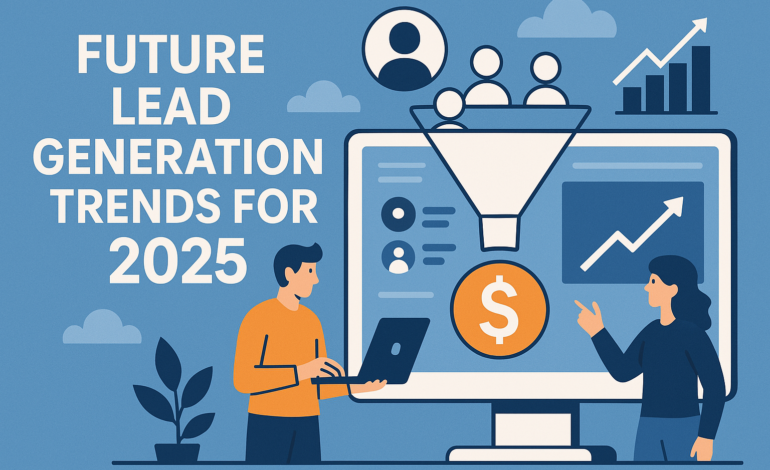
Future Lead Generation Trends to Watch in 2025: Strategies for Staying Ahead
The world of lead generation is in flux. As 2025 approaches, businesses must rethink outdated tactics and embrace innovations that align with evolving consumer expectations, technological advancements, and stricter privacy norms. The future belongs to brands that focus on being real, use new tools, and build trust.
Today, many people are skeptical of traditional marketing. Let’s unpack the trends set to dominate lead generation in 2025 and how your business can adapt to stay competitive.
1. Hyper-Personalization: From Generic to Genuine Connection
The End of One-Size-Fits-All Marketing
Personalization in 2025 isn’t just about addressing leads by their first name or segmenting email lists. Crafting experiences so tailored that customers feel like your brand understands them is essential.
Thanks to AI and machine learning, businesses can now look at a lead’s digital footprint. This includes social media activity, past purchases, browsing behavior, and even feelings in customer support chats. With this information, they can predict what the lead needs before the lead says it.
For example, picture a financial advisory firm using AI. It can see when a lead searches for “retirement planning for freelancers.” The system sends them a personalized email.
This email includes a video explainer, a downloadable checklist, and a calendar link. They can use the link to book a free consultation. All this happens within hours of their search.
Predictive Lead Scoring: Quality Over Quantity
Tools like HubSpot’s AI-powered analytics and Salesforce Einstein are making lead scoring smarter. These platforms do not just use basic demographics.
They look at behavioral signals instead. This includes time spent on pricing pages, engagement with case studies, and attendance at niche webinars. A B2B software company might focus on leads who watched a demo video and downloaded a technical whitepaper. This shows they are serious about buying.
The Data Dilemma
Hyper-personalization hinges on data—specifically, first-party data. With third-party cookies disappearing, companies must incentivize customers to share information directly. Interactive quizzes, such as “Find Your Perfect Product in 60 Seconds!”, will be important. Loyalty programs will also play a key role.
Additionally, free tools like ROI calculators will be significant. They help gather insights and provide immediate value.
2. Privacy-Centric Strategies: Trust as a Competitive Advantage
Zero-Party Data Takes the Lead
Google is stopping third-party cookies. Rules like GDPR and CCPA are becoming stricter. Because of this, businesses can no longer depend on hidden tracking. Zero-party data—information customers voluntarily share through surveys, preference centers, or polls—will dominate.
Look at Spotify’s annual “Wrapped” campaign. It encourages users to share their music habits for personalized playlists. This way, Spotify makes data collection a viral moment. Similarly, e-commerce brands like Sephora use beauty quizzes to recommend products while capturing valuable preferences.
Contextual Advertising Makes a Comeback
Privacy concerns are making people interested in contextual ads again. These ads show promotions next to relevant content instead of tracking users online. A travel agency might place ads on a blog post called “Top 10 Eco-Friendly Resorts in Bali.” This targets travelers who value the environment.
Transparency as a USP
Brands that openly communicate how they use data—and safeguard it—will win loyalty. Consider adding a “Why We Collect This” section to lead capture forms or publishing plain-language privacy policies. Patagonia’s “Footprint Chronicles,” which details its supply chain ethics, exemplifies how transparency builds trust and drives conversions.
3. Video Content: The Undisputed King of Engagement
Short-Form Video for Top-of-Funnel Impact
Platforms like TikTok, Instagram Reels, and YouTube Shorts aren’t just for dance challenges. By 2025, 88% of marketers plan to use short-form video to generate leads (HubSpot). A B2C brand could create a 15-second teaser showcasing a product’s unique feature, ending with a swipe-up link to a landing page. For B2B, think bite-sized LinkedIn videos explaining a complex service in simple terms.
Interactive and Shoppable Videos
Interactive videos let viewers choose their own journey. A home decor brand could create a “Design Your Dream Living Room” feature. Users can click on furniture items to see prices or ask for a catalog.
Shoppable videos are popular in China’s live-stream shopping. They let viewers buy items instantly during broadcasts. Experts expect this trend to grow worldwide.
Webinars and Live Streaming for Deep Engagement
Long-form content isn’t dead. Gated webinars remain a goldmine for B2B lead generation, especially when paired with post-event nurture sequences. Meanwhile, live streaming on LinkedIn, Twitch, or even Discord enables real-time interaction. A SaaS company might host a live demo with a Q&A session, offering a free trial to attendees who provide their email.
Repurpose, Repurpose, Repurpose
Maximize ROI by turning video transcripts into blog posts, podcast episodes, or infographics. Clip key moments from webinars for social media teasers, driving traffic back to gated full-length content.
4. Voice Search Optimization: Capturing the “Hey Google” Generation
Conversational Keywords Are Key
Over 50% of U.S. households own smart speakers, and 27% of consumers use voice search daily (Microsoft). To rank for voice queries, optimize for natural language. Instead of “best CRM software,” target phrases like “What’s the easiest CRM for a small team?” Tools like AnswerThePublic or SEMrush’s Keyword Magic Tool can help identify long-tail, question-based keywords.
Local Businesses, Significant Opportunities
“Near me” searches via voice are booming. A bakery can improve its chances for “Where can I find vegan cupcakes near me?” by adding keywords. They should include words like “vegan,” “gluten-free,” and “freshly baked” in their Google My Business profile. Voice-optimized content should also feature concise answers (under 29 seconds) to align with smart speaker behavior.
Voice Apps for Lead Capture
Brands are developing custom Alexa Skills or Google Actions to engage users. A real estate agency might create a voice app that provides weekly market updates in exchange for an email address. “Hey Alexa, ask HomeFinder about 3-bedroom homes in Austin” becomes a seamless lead generation tool.
5. AI-Driven Account-Based Marketing (ABM): Precision at Scale
Identifying High-Value Accounts with AI
ABM platforms such as Demandbase and Terminus now use AI. They analyze firmographics, intent data, and employee sentiment from sites like Glassdoor.
A cybersecurity vendor may discover something interesting. Healthcare companies with more than 500 employees are three times more likely to convert after a data breach. This finding can lead to timely and tailored outreach.
Hyper-Targeted Campaigns
Once high-potential accounts are identified, personalize every touchpoint. Send decision-makers personalized video messages referencing their recent blog post or LinkedIn activity. Use dynamic website content to display case studies relevant to their industry when they visit your site.
Measuring ABM Success
Track metrics like account engagement score, pipeline velocity, and deal size rather than vanity metrics. A 2024 Forrester study found that companies using AI-driven ABM see 32% higher deal closure rates, proving its ROI.
6. Sustainability and Ethics: The Non-Negotiable Drivers of Choice
Green Marketing as a Lead Magnet
A 2023 Nielsen report revealed that 78% of consumers prefer eco-conscious brands. Highlight sustainability in lead magnets. Offer a free “Guide to Reducing Your Carbon Footprint” for email sign-ups.
Show ESG certifications on your landing pages. Outdoor brand Cotopaxi uses its “Radically Transparent” sourcing ethos to attract ethically minded buyers.
Avoiding Greenwashing Pitfalls
Consumers can spot insincerity. Back claims with data: Share annual sustainability reports, partner with verified organizations, or highlight specific initiatives like carbon offset programs. TOMS Shoes’ “One for One” model and Patagonia’s Worn Wear program are benchmarks for authenticity.
7. Immersive Tech: Metaverse and AR/VR Reshape Engagement
Virtual Events and Showrooms
The metaverse isn’t just for gamers. Brands like Hyundai and Nike hold virtual product launches in places like Decentraland. Attendees can explore digital showrooms and meet with avatars. Require email sign-ups to access exclusive post-event resources or discounts.
AR Try-Before-You-Buy Experiences
IKEA’s AR app, which lets users visualize furniture in their homes, boosted conversions by 14%. In 2025, B2B industries will adopt similar tech. A medical equipment supplier could offer a VR demo letting surgeons “test” devices in a simulated operating room.
NFTs as Lead Magnets
While speculative, NFTs offer unique opportunities. A SaaS company could give away NFTs. These NFTs would allow access to special webinars or new features. This would turn collectors into serious leads.
8. Advanced Chatbots: From Scripted to Strategic
AI-Powered Conversations
Modern chatbots like Drift and Intercom use NLP to handle complex queries, qualify leads, and even book meetings. A chatbot on a law firm’s website might ask, “Do you need help with intellectual property or employment law?” It can then direct the lead to the right attorney.
Proactive Engagement
Set chatbots to trigger messages based on behavior. If a lead spends 5 minutes on a pricing page, the bot could offer a live demo or discount code. Post-chat, integrate data directly into your CRM for seamless follow-ups.
9. Micro-Influencers and Employee Advocacy
The Power of Niche Influencers
Micro-influencers (10k–100k followers) drive 60% higher engagement than macro-influencers (Influencer Marketing Hub). A B2B cybersecurity firm could team up with an IT podcast host. They would promote a gated eBook on ransomware prevention. This would reach a highly specific audience.
Turn Employees into Ambassadors
Encourage staff to share company content on LinkedIn. Adobe’s employee advocacy program creates 30% of its social media leads. This shows that real endorsements from peers are effective.
10. Community-Driven Growth: Building Loyalty, Generating Leads
Branded Communities
Platforms like Discord, Slack, and Circle foster direct engagement. Gaming giant Razer boasts an 18 million-member community that beta-tests products and crowdsources ideas. Offer exclusive content or early access to members, requiring sign-ups to join.
User-Generated Content (UGC) Campaigns
Run contests encouraging customers to share photos or testimonials with a branded hashtag. GoPro’s #GoProAwards campaign generates thousands of leads monthly while building social proof.
Preparing for 2025: Actionable Steps to Start Today
- Audit Your Data Strategy: Shift focus to first-party and zero-party data collection.
- Experiment with AI Tools: Test chatbots, predictive analytics, or AI content generators.
- Invest in Video: Repurpose existing content into short-form clips or webinars.
- Optimize for Voice: Audit your website for conversational keywords and FAQ pages.
- Build Trust: Update privacy policies and highlight sustainability efforts.
Final Thoughts
The future of lead generation is dynamic, but not unpredictable. By embracing hyper-personalization, prioritizing privacy, and experimenting with immersive tech, businesses can build meaningful connections that convert. The key is to start small, measure relentlessly, and stay agile. After all, 2025 isn’t just a date—it’s a new mindset.


